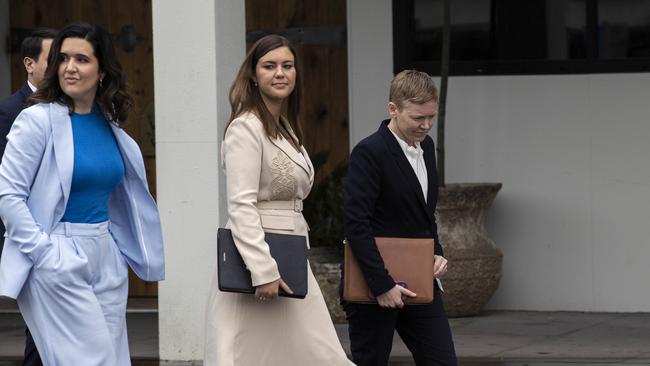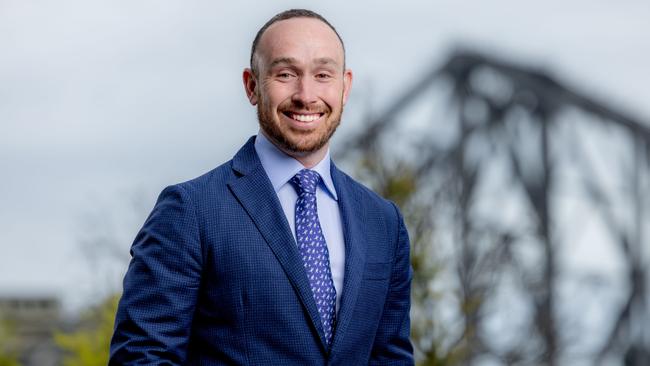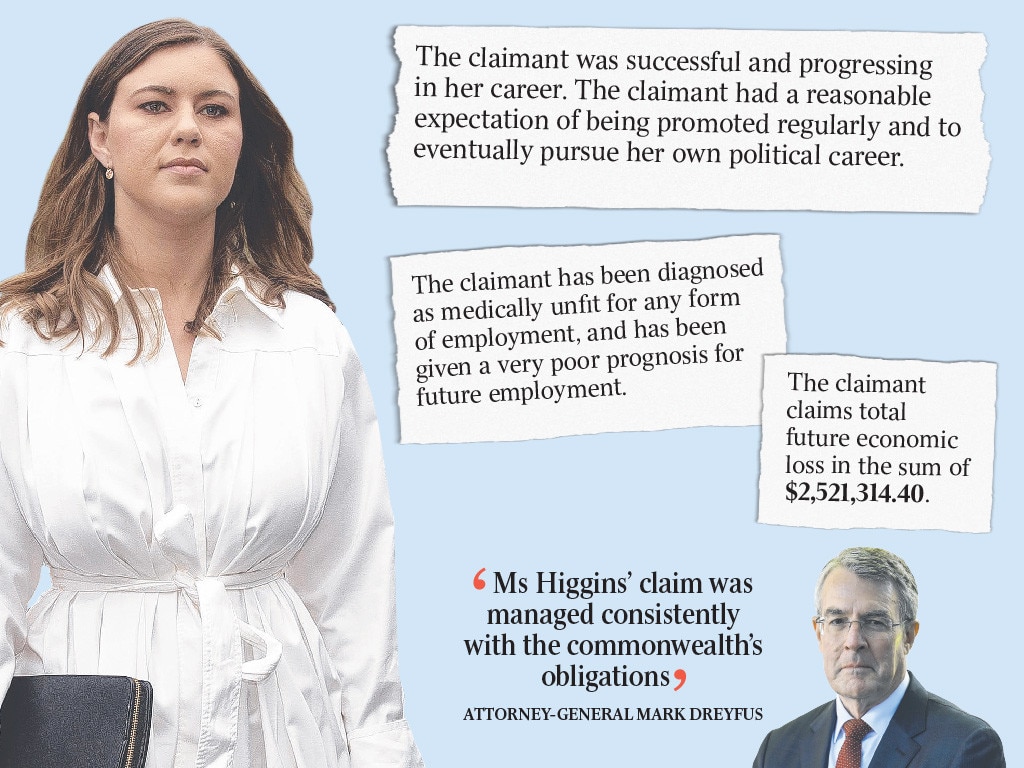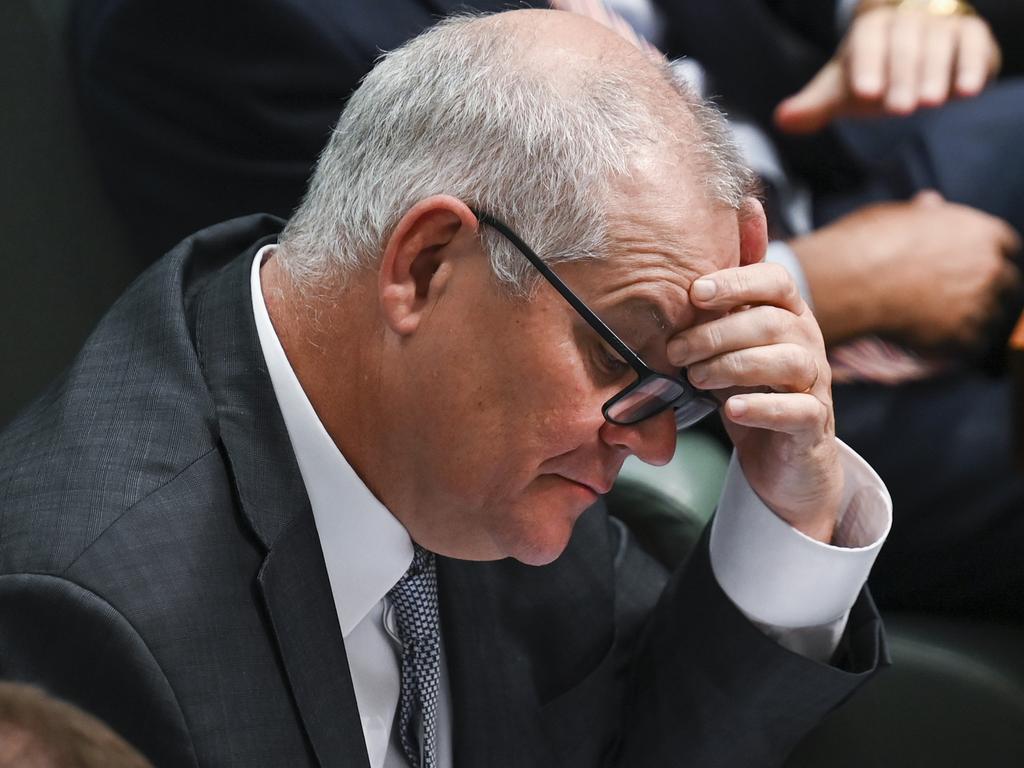Brittany Higgins, Bruce Lehrmann and David Sharaz: an anatomy of a political scandal
Brittany Higgins’ book appears to have been shelved. One look at the rough draft and it’s not hard to understand why.

Those 51 words are included in the beginnings of a draft book by Brittany Higgins. If the book was completed, it hasn’t been published. And it is not hard to understand why it may have been shelved. Higgins may be a household name but to many women it’s far from clear she is the epitome of an empowered young woman. Whether she is any kind of role model for women at all increasingly is being questioned.
Inquirer has seen parts of what Higgins calls a “rough” draft outline of her proposed book to be published by Penguin Random House. A draft was sent by Higgins to the publisher in April 2021 – four months before her alleged assailant, Bruce Lehrmann, was charged in August with one charge of sexual intercourse without consent. Lehrmann has always maintained his innocence.
This draft book is headed #NotJustADaughter and is dedicated to David Sharaz. It consists of 35 chapter headings with notes under each, from chapter one, headed “Freedom of Speech”, to chapter 35, headed “Restoration”. Then there is a timeline and just over 12 pages of “Book Contents” followed by material noted under “Future use – Research/Notes”.

Had the book been completed, it might have borne no resemblance to material in this draft. Nonetheless, the draft book seen by Inquirer gives an insight into how Higgins appeared to have planned, in at least early 2021, on using the media and politics in what became the nation’s biggest political sex scandal.
Extracts reveal Higgins writing more about a political and media scandal than about a police investigation. One section of the draft book includes this: “The Liberal Party had spent the last three years training me how to play media games. If I was going to do this, I was going to do it right. It had to be seamless. It needed to be done before a sitting fortnight. They had to front questions and cameras. There would be an inevitable lull in the media cycle following Covid-19. I had considered sitting on this for another few months but as soon as we the Party moved into election mode, they would be churning out stories and announcements on an almost daily basis. If this was going to happen it was now or never.”
Another section of the draft book includes this: “We had become quite a twosome when it came to game planning. My experience as a media adviser, David’s experience as a producer; together we understood how the gallery media sphere operated.”
There is a section of notes towards the end of the draft headed: “Journalists in media scandals”.
This section includes the following: “In the case of scandals, ‘passionless detachment’ quickly gives way to a passionate ‘attached journalism’ of indignation which slips easily into advocacy.”
To many people, the more material that comes to light, the more this young woman appears to be the human casualty of a political scandal, the willing victim of politicians, especially female politicians, and women in the media who seem to have spent the past few years using her rape allegation in a minister’s office to pursue their own ends.
Another part of the draft book seen by Inquirer covers Higgins and Sharaz war-gaming the meeting with prime minister Scott Morrison.
“I had war gamed the meeting. I would fly to Canberra. I would allow myself to be at the mercy of the press gallery again. Why did I have to come up with the agenda and the solutions to these deeply complex problems as well. For the past few months, I had kept waiting for a political saviour to come valiantly into the mix and salvage the situation. To take the reins of this movement and turn it into meaningful change. Peta, Julie, Julia perhaps? No such figure emerged. I liken it to the Greek myth of Sisyphus. Punished by Zeus and forced to spend an eternity pushing a boulder up a hill. It was still just me, facing what felt like an immovable force. And for what? To be abused online? To muddy the waters in a criminal case? To make enemies of former friends? To alienate myself from potential employees? The reasons not to press forward felt endless. The truth of it was that I was always going to follow this through. Why? Because it was the right thing to do.”
Another part of the draft book is headed “Scandal in politics” and includes this: “The media is orientated towards themes rather than facts. Their day-to-day output continues to tell merely several stories in instalments. Political power is becoming more and more inseparable from the correct handling of scandals. Politicians who have the most friends in the press gallery enjoy the longest political lives.”
Yet another part includes this about “Political Scandals in media”: “The pragmatic goal is set by the subject and journalists accept it because it fits well within their institutional purpose. The epistemic object of scandal is a story which does not exist as a fact but because the story is a cultural teleology. To determine what behaviour of a politician may provoke a scandal is something that depends on the cultural framework where such behaviour is made meaningful.”
None of this is earth-shatteringly interesting. By Higgins’s own admission it is an early draft. Some of it is entirely in note form, such as this section headed “RESEARCH/NOTES
“Overview:
“Major themes: Innocence – Horror – Triumph.
“Key Milestones: Assault – Cover up – Media storm.
“Words: 90,000.”
The former staffer then compiled what she called “Dickinson Character Hooks”.
“Bruce Character: RM wearing, suit wearing, born to rule, Northern Beaches elite, deep family ties to the republican party and Cheshire cat grin.
“David Character: Well intentioned, earnest, talkative, disheveled, communicator, funny and self-depreciating, awkward glasses move.
“Reynolds Character: Nervous, eager to please, self-serving, ambitious, cowardly, intolerant. Carla Zampatti wearing party loyalist.
“Ciobo Character: Laissez-fare, privileged, bored, spoiled, flirty, charismatic, boyish quality.”
There is a section in the draft book headed “Trial by media” that says: “Did I do something bad?” “This whole precident (sic), this trial by media?” “Is this all my fault? I cried into David’s chest.
“Honestly, I didn’t feel like I had a choice. There was no other way, I weeped. Exhaustion had sunk it.”
Even in rough draft form, Higgins’s book is a window – if a somewhat clumsy one – into what appeared to be driving her at the time: being part of a political scandal that might turn journalists into advocates and ensnare people in power.
The draft doesn’t stand alone either. It has been reported that police found a text exchange on Higgins’s phone dated six weeks before the alleged rape. She and former boyfriend Ben Dillaway appeared to be joking about wanting a political sex scandal.
“The bar for what counts as a political sex scandal nowadays is REALLY low,” Higgins wrote.
“I want a sex scandal I can be like whoa. Impressive. Didn’t think he had it in him,” Dillaway wrote.

“Exactly! A sex scandal the party can be proud of. Another Barnaby but without the baby haha,” Higgins responded.
Inquirer has been told of a note on Higgins’s phone dated May 2020 that featured lines about “Anatomy of a Political Scandal”. It started with the word “thesis” and mentioned “media lens of a political sex scandal”. During cross-examination of Higgins on the Friday afternoon of the first week of the trial, ACT Chief Justice Lucy McCallum intercepted this piece of evidence, refusing defence lawyers’ requests to ask Higgins about it. It was never tendered. “Anatomy of a Political Scandal” appears to have been written around the time that Higgins and Sharaz became an item. The note is dated many months before The Project interview, and well before Sharaz and Lisa Wilkinson exchanged emails headed “#MeToo Liberal Party Project Pitch”.
There are sound reasons many people are troubled by what they see as Higgins’s fixation on a political sex scandal – evidenced by texts, notes and in her draft book.
Somewhere in this saga is an allegation of rape. And this is what makes this story such a dismal episode for the so-called women’s movement. People such as Heidi Yates, the ACT Victims of Crime Commissioner, have lauded Higgins for her advocacy work. But what precisely has Higgins become an advocate for? To many women, Higgins has become known, most famously, as the woman who chose to go to the media first, to politicians second, and to the police, to lodge a formal complaint, third.
I don’t recall Higgins saying, in hindsight, this was a mistake. I can’t recall her saying, with the benefit of hindsight, women should go to the police first because the media and political storm has not been good for me. That’s a shame because it means Higgins has become the wrong kind of role model for many women. For some women who are ensconced in politics, it might not be as apparent why feeding a political scandal was a flawed priority. But for many other women there is another lesson from the Higgins saga.
It goes like this: putting the media and politics ahead of the criminal justice system did nothing to help a prosecution. Appearing at the March4Justice when she was due to meet AFP officers suggested to many that Higgins’s priority was not the criminal justice system.
Her pursuit of a book deal, with the help of Peter FitzSimons – even before Lehrmann had been charged – would always risk painting her in a poor light as a woman who was more focused on the media than on rape prosecution. Perhaps Higgins can’t see that yet. Perhaps she never will. But there are telling signs she can’t have missed. Two days after this newspaper published text messages between Higgins and Sharaz revealing how the pair planned to enlist the help of senior Labor figures to pursue Higgins’s rape allegation and her claim the Coalition government covered it up, Tame was reported as deleting an Instagram post where she called Higgins “a national hero” and described her as a “warrior” and “my friend”.
Other sections of the media also appear to have become more curious about this saga instead of simply joining the droning echo chamber of Higgins supporters.
Higgins has a few things in common with Meghan Markle, who railed against an institution and assumed that the more media she did, the better it would be for her credibility. Markle learned some sections of the media were more curious than others. And that curiosity, testing many of Markle’s claims, hasn’t turned out well for her credibility or her celebrity.
Similarly, Higgins and Sharaz were mistaken if they imagined they could control how their story would play out. Relying on “friendlies” in politics and the media was always doomed to end badly, not just for Higgins but for the “friendlies”. Both have lost credibility. Higgins is no role model and the “friendly” journalists are reduced to complaining that while it was fine for Higgins to use media as a tool, media who discover the truth must suppress it if it paints Higgins in a less than flattering light.
Once Higgins chose the media and politics over police, information that exposes the extent of Higgins’s political and media manoeuvrings must be made public.
Rape is too serious a crime to be pursued by media trials and political crusades. Rape, when it happens, warrants a jail term. And only the criminal justice system should be allowed to do that. Taking short cuts, via the media or politics, is the worst possible course for women. Higgins took the short cuts. In the draft book, she describes having her name associated with the March4Justice as likely being “the most defining moment of my life”.
Higgins is young. Hopefully she will go on to do great things. But there is always the risk that the most defining event of her life will turn out to be her role in turning an allegation of a serious crime into a political-media circus.






“Honestly, I feel like a B-grade Grace Tame. She exists outside and beyond the political bubble. Court case closed, awarded and revered. Here I am in the mud with the pigs – fighting for control of the daily news cycle. Throwing mud: A WhatsApp here, a voicemail there, a drop to Sam.”